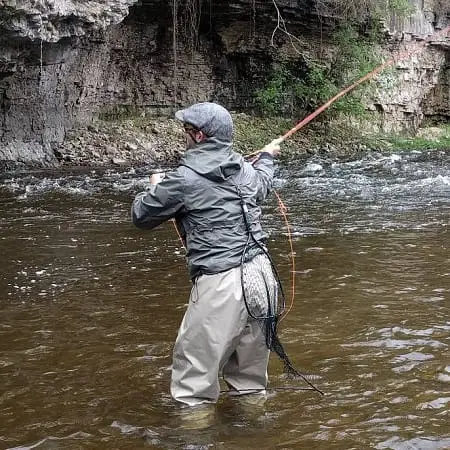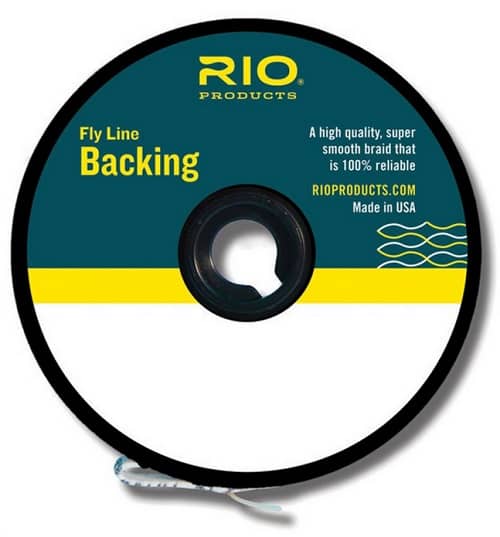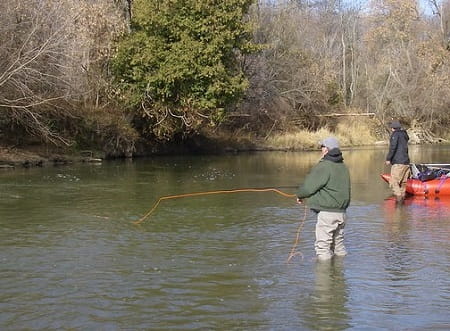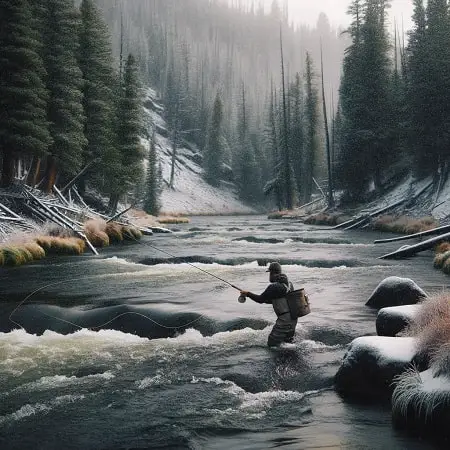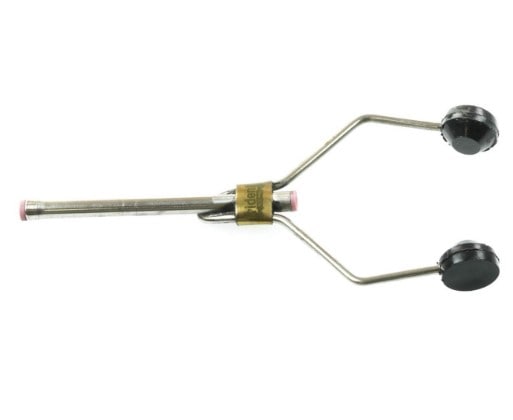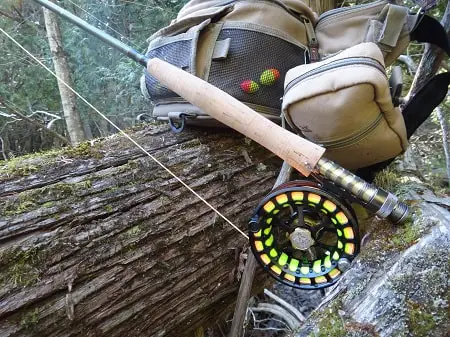Tippets For Fly Fishing Explained: A Guides Perspective
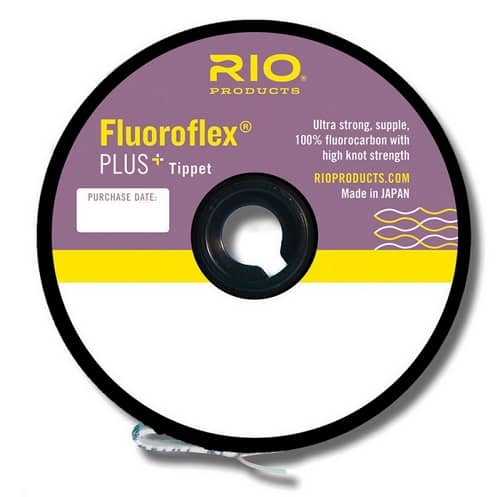
A tippet connects the fly to the leader and generally is less visible than the leader or the fly line.
The tippet helps to improve casting distance and accuracy while fly fishing. The tippet also helps to hide the thick and often brightly colored fly fishing line used to cast and locate the fly. Tippets are made from nylon, monofilament, or fluorocarbon line.
What Is The Difference Between A Fly Fishing Leader And A Tippet?
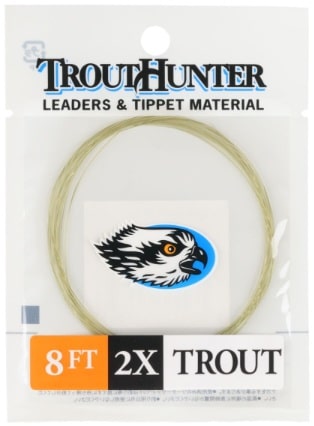
Fly fishing leaders create a less visible transition from the fly line to the tippet. The leaders enable the gradual tapering of the thicker fly line and connect to the even lighter and thinner tippet.
A leader is about 9 feet in length, while the tippet material is shorter and much thinner, lighter, and less visible than the fly fishing leader.
The tippet also makes it easier to change flies by attaching them to the tippet instead of the leader when fishing dry flies.
How Do You Know What Size Tippet To Use?
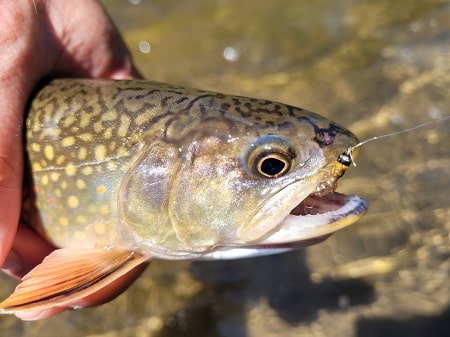
Some say it’s about the size of the fly when choosing your tippet size, but that is wrong.
You choose your tippet based on the fish and its ability to see the tippet.
You also choose your tippet based on the potential for breaking.
When streamer fishing for 4 to 6 pound trout, the streamer moves fast so the fish are not likely to see the tippet. The fish strike hard too so it is necessary to upsize to a 10 to 12 pound tippet so they do not break you off on the strike..
However, when nymphing or dry fly fishing for the same sized trout, the fly is moving slowly and the fish might see your tippet. So, I will often use a 2 to 4-pound tippet.
You see, it’s not about the size of the fly. It’s about balancing between a tippet the trout won’t see while still being strong enough that you won’t break off.
I go into more detail about matching tippet sizes and applications and fish sizes below.
You want a leader and tippet that tapers gradually from the fly line to the fly without scaring the fishing with the typically thicker and more visible fly line.
Using the correct size leader and tippet also helps to make casting easier by transferring the energy of the cast smoothly from the fly rod through the line, leader, and tippet right up to the fly.
Tippet Sizing: Understanding The “X” System
The X system for tippet sizes relates to their diameter and breaking strength. The larger the number, the thinner and lighter the tippet is for fly fishing.
The sizes range from 8X as the thinnest and lightest tippet to 03X for the thickest, heaviest, and strongest tippet. You would want to use a thick and heavy tippet for catching larger fish with larger flies.
A lighter and thinner tippet makes it easier to use small flies to catch wary fish.
What Are Separate Spools Of Tippet Used For? Why You Need More Than One.
The separate spools of tippet material enable you to match the tippet when you change the size fly that you are using to catch fish.
The more spools that you have, the more varied your fly fishing can be so that you have the best chance of catching fish.
When you have several tippets, they make it much easier to change your presentation without having to switch to another fly rod or even change the fly line.
Tippet Material for Fly Fishing: What Is Tippet Made Of?
Tippets usually are made from nylon, monofilament, or fluorocarbon. Each offers its unique features that make fly fishing much easier to do by tapering the thickness from fly lines through the leaders and tippets to the flies.
What’s the Difference Between Monofilament and Fluorocarbon Tippet?
The differences between a tippet made from monofilament and one made from fluorocarbon are the same as lines made from monofilament and fluorocarbon.
The monofilament is lighter and floats better than fluorocarbon, which makes it ideal for topwater fishing with a floating line or tippet.
The fluorocarbon is denser and creates a thicker tippet diameter that is also harder to see than monofilament tippets. Fluorocarbon also has more stretch and abrasion resistance than monofilament, which makes it a better sinking line and tippet for fishing with flies and lures that also sink.
Can I Use Regular Fishing Line As Tippet?
If you are caught in a pinch with no tippets on hand, you certainly could make your own tippet to attach to a tapered leader while using the monofilament line that you normally would use for spin fishing. You would be limited by the type of fishing line that you have and likely would lack the variety needed for changing flies. Yet, you could use monofilament to make a tippet, although it is not the ideal material.
Can I Use a Fluorocarbon Fishing Line As a Tippet?
You can use fluorocarbon fishing line to create tippets. Fluorocarbon is an ideal material due to its strength and abrasion resistance. It also is harder to see than monofilament, which typically floats on top of the water.
You would want your fluorocarbon tippets to be much shorter than fluorocarbon leaders that help to create an ideal taper from fly lines to the flies or fishing streamers that fly fishers commonly use to catch fish.
3 Best Monofilament Tippets
Monofilament is commonly used as leader and tippet material for topwater lures and flies. The material is abrasion-resistant and ties nicely to a thicker fly line and leader. Here are three of my favorite monofilament tippets:
Rio Hard Mono, which is specially formulated to be abrasion-resistant and stiff to help you cast more accurately with your fly rod.
Scientific Anglers, which uses a proprietary copolymer blend to limit water absorption and enhance knot strength greatly.
Orvis Leader & Tippet, which gives you a tapered monofilament line that is ideal for connecting flies to leaders and enables you to transfer the energy from the fly rod through the fly line to the fly while casting.
3 Best Fluorocarbon Tippets
Fluorocarbon gives you strength and low visibility with a tapered line that is ideal for creating a leader and tippet to connect your fly line and fly for accurate casts with optimal energy transfer. Here are my three favorite makers of fluorocarbon leader and tippet materials:
Scientific Anglers Absolute Fluorocarbon Tippet uses a dual-layer construction to make the tippet softer on the outer layer for better knots, while the inner layer greatly increases tensile strength to help you catch more fish while fly fishing.
TroutHunter, which offers excellent fluorocarbon leader and tippet material that has the exceptional strength needed to haul in larger fish.
Rio Fluoroflex, which gives you exceptional breaking strength and a softer outer layer that enhances the knot strength for catching big fish while fly fishing.
What Is The Best Tippet For Trout?
A fluorocarbon tippet is the best for trout due to its thin design, invisibility in water, and overall strength.
What Is The Best Type And Size of Tippet For Trout?
A fluorocarbon tippet that is size 5X will work nicely for most types of trout fishing.
What Is The Best Tippet For Bass?
A tippet that is rated for between 10 and 20 pounds and tied to a larger gauge leader often works very well for catching bass.
What Is The Best Type and Size Of Tippet For Bass?
Fluorocarbon tippets that are between 1X and 3X in size generally work best for bass fishing.
What Is The Best Tippet For Steelhead?
Steelhead are notoriously hard fighters with good vision and are very finicky while spawning, so tippets about 2 or 3 feet long often work well.
What Is The Best Type and Size Of Tippet For Steelhead?
A 0X to 3X fluorocarbon tippet with between 6 and 15-pound test strength is ideal for steelhead fishing.
What Is The Best Tippet For Salmon?
Salmon are another popular species that make annual spawning runs after growing big and fat, so you need one that is rated for at least 15-pound test to help withstand hard-fighting salmon.
What Is The Best Type and Size Of Tippet For Salmon?
A 0X tippet made from fluorocarbon is ideal for targeting salmon.
What Is The Best Tippet For Fishing With Dry Flies?
Dry flies are relatively light and float on top of the water, so you need a light and limber tippet to match up well with, which I have found to be traditional nylon that likewise is light and it floats on top of the water.
What Is The Best Type and Size Of Tippet For Dry Fly Fishing?
You need light tippets made from nylon and are between about 8X and 4X in size when fishing with a dry fly.
What Is The Best Tippet For Streamer Fishing?
Its relatively thick girth and weight make fluorocarbon the ideal type of tippet when you are fly fishing with streamers.
What Is The Best Type and Size Of Tippet For Streamer Fishing?
You should use fluorocarbon or monofilament tippets that are 3X or larger when using streamers to target bigger fish.
What Is The Best Tippet For Nymphing With Indicators?
Nymphing with indicators requires the kind of sensitivity that you get from thinner fluorocarbon tippets so that you can better see the action of the indicator when a fish takes your fly.
What Is The Best Type and Size Of Tippet For Nymphing?
Fluorocarbon tippets that are between 8X and 4X in size with between about 2 pounds and 6 pounds of breaking strength are good for nymphing for fish.
What Is The Best Tippet For Euro Nymphing?
Anglers who enjoy Euro nymphing typically use small and light flies to catch fish that might have some side to them, so light fluorocarbon tippets are often the best choice.
What Is The Best Type and Size Of Tippet For Euro Nymphing?
You should have a variety of tippets that enable the nymphs to sink while the tippets remain hidden, which means using fluorocarbon nymphs ranging from about 7X to 4X in size.
Can You Fly Fish Without A Tippet?
You can fish without a tippet — especially when using big flies, but the tippet makes it much easier to cast accurately and transfer the energy to the fly.
Can Trout See The Tippet?
Trout have excellent vision, which makes it possible for trout to see a brightly colored fly line but not a properly selected tippet that is virtually invisible.
Setting up a leader and tippet
Many anglers prefer a setup that uses the fly line with about 9 feet of tapered leaders and an even thinner tippet that they can tie to a fly.
Tippet Size Chart for Fly Fishing
You can use a convenient size chart for tippets, which are readily available online, or just use the simple formula of dividing the fly size by three to get the correct size for your tippet.
Ideal Tippet Length for Fly Fishing?
I like to use tippets that are about 4 feet in length with a leader that is about 9 feet or more, but others might prefer a shorter leader.
Tippet Accessories
You can buy accessories that help to make it easier to use tippets when fishing. Commonly used accessories include rings and holders for your tippets.
What Are Tippet Rings for Fly Fishing?
Tippet rings are a collection of small metal rings that you can tie to the end of the leader so that you can tie a tippet to it. You only need one ring per line fly line and can trim the tippet instead of the leader when changing flies.
What is a Tippet Holder for Fly Fishing?
A tippet holder has a short post upon which you can place several tippet spools that you can use while fly fishing. The holder is often attached to a clip that you can latch onto a belt loop or another item. The holder might also be attached to a necklace-like ribbon that you could wear around your neck or loop around a belt or another convenient attachment point.
Matching Tippet Sizes with Tapered Leaders
When extending the length of your leader or modifying its poundage, having a spool of tippet on hand becomes crucial.
There are two ways to think about the right tippet for your leader. I highly recommend using a tippet one size smaller than your leader. This means adding a 4x tippet to a 3x leader.
The tippet is one smaller. The reason I do it this way is so that if I do break off a fly, it is more likely to break off at the fly, and I won’t lose both my tippet and my fly.
However, some anglers prefer matching the tippet material to your tapered leader for optimal performance. This means using a 6 x tippet on a 6 x leader.
1x Tippet: Embracing Heavier Lines
By pairing a 1x tapered leader with a 1x tippet, you can confidently handle heavier lines. This combination proves useful when targeting robust fish or using large streamer patterns.
2x Tippet: Versatility in Moderation
If you desire a slight decrease in line strength or suspect that fish might be slightly more cautious, scaling down to a 2x tippet is an excellent option. It maintains a balance between strength and subtlety, catering to various fishing scenarios.
Exploring Further Options
While the sizes and combinations I’ve shared cover the majority of freshwater fishing situations, it’s worth noting that standard monofilament tippets in these sizes will suffice for 90% of your fishing needs.
However, for those who love diving into the nitty-gritty details, I’ve prepared a comprehensive chart detailing the diameter, poundage, and specific uses of various tapered leader and tippet sizes.
Feel free to take a screenshot, jot down the information, or simply study it at your leisure.
And there you have it—the basics of tapered leaders and tippets. I hope this information has proven helpful in your fishing journey.
If you’re new to fly fishing or missed the first video in this series, be sure to check it out here [insert link] for a comprehensive overview of essential gear to include in your fishing bag.
To recap, we’ve covered the essentials of tapered leaders and tippets, providing you with a simplified guide to choosing the right equipment for your fishing adventures.
Remember, the sizes and combinations I’ve recommended will cater to the majority of freshwater fishing situations you’ll encounter.
If you’re just starting out with fly fishing, I hope this information has set you on the right path and instilled confidence in selecting the appropriate leaders and tippets for your needs.
As you gain experience and explore different fishing scenarios, don’t hesitate to experiment with various sizes and brands to find what works best for you.
Do You Need To Add A Tippet To Your Fly Fishing Leader?
Yes, you do need to add a tippet section to your fly fishing leader, or at least you should since there are some benefits to adding a tippet.
The way I explain tippet to my new fly fishing students is the tippet goes on the end of your leader, so basically, it’s the tip of your leader where your fly is tied.
The are a couple of reasons for a tippet.
A tippet is not tapered, it’s all one diameter, and therefore you can cut off and tie many flies onto a 12 to 30-inch tippet, and the line will never get any thicker. Each time you cut a fly off and tie a new one on, you lose about two to three inches of line.
If you don’t use a tippet and you tie your flies directly to your tapered leader, after changing five or ten flies, you will cut into your leader, and eventually, your leader where you tie the fly will get too thick, which means the fish might see it. The leader will also eventually get too short.
Using tippets also greatly extends the life of your leader. I will often use the same leader all season, and I tie on a crap load of flies, and my leader stays in good shape because I keep adding new tippets with either a knot or a tippet ring.
How long should you’re tippet be?
Determining how long your tippet should be will depend on the method you use, but as a general rule, I like to use a tippet that is about 20 to 30 inches.
- Dry Fly Tippet Lenght: Your tippet for dry fly fishing should be 24 to 30 inches.
- Nymphing Tippet Lenght: Your tippet length for nymphing should be 20 to 30 inches
- Streamer Fishing Tippet Length: 16 to 24 inches
Tippets For Fly Fishing Q&A
As we near the end, I want to take a moment to extend my heartfelt thanks to all of you who have accompanied me on this incredible adventure. Your unwavering passion for this magnificent sport binds us together as a tight-knit community of devoted anglers.
Should you have any questions, tip, or advice regarding tippets for fly fishing I encourage you to drop a comment below and keep the discussions and education going. Also, don’t forget to share or join un on social media.
Tight Lines,
Graham

